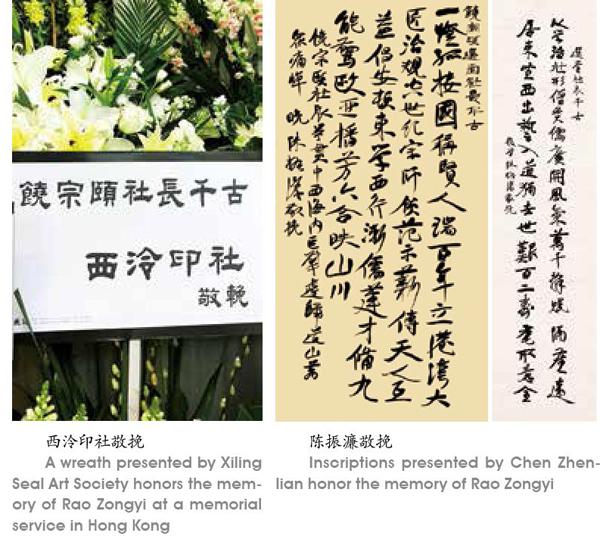饶公虽去星犹在
2018-04-04刘慧
刘慧
金石有缘长相忆,湖山珍重永留馨——2018年2月28日上午,西泠印社饶宗颐社长追思会在香港举行,人们向饶公作最后致敬,冀饶公一路走好。

饶宗颐先生一生为社会贡献良多,深受社会各界人士敬重。在300余人的追思会上,既有政界、文化界及教育界的知名人士,还有多个以饶宗颐名字命名的研究院、文化馆等团体。
饶宗颐先生是蜚声中外的学界泰斗和艺术大家,毕生致力于学术研究与教育事业,学域广博,创辟多方,才情丰茂,著述宏富,为当代国际汉学界导夫先路的一代宗师,享有崇高的学术地位和影响。饶公的学术、艺术人生和杰出成就,代表了中国传统学术文化在当代可能达到的最高点,其懿言嘉行、学术文章,并足仪范后世,垂百代而不灭。
中国文联副主席、西泠印社副社長兼秘书长陈振濂等出席追思会。并撰联追思饶宗颐社长——
饶宗颐选堂社长千古
一灯孤接国称贤,人瑞百年立港湾。
大匠治规空世纪,宗师领范示薪传。
天人互益倡安顿,东学西行渐儒莲。
才备九能惊欧亚,播芳六合映山川。
选堂社长千古
以学治社,形僧质儒,广开风气,万千辞赋隔座远;
居东望西,出艺入道,独去世艰,百二寿耄取意全。
——后学陈振濂敬挽
一

饶宗颐先生1917年出生于广东潮州,幼承家学,致力于地方文史与文献目录之学,崭露头角,弱冠即侧身名儒,专精学问。上世纪40年代以来,先后任中国香港大学、新加坡国立大学、法国巴黎高等研究院、美国耶鲁大学、日本京都大学、香港中文大学教授与法国远东学院院士、法兰西学院院士等,曾获法国法兰西学院颁授有“汉学界诺贝尔奖”之称的“儒莲奖”、法国文化部颁授高等艺术文化勋章、中国香港特区政府颁授大紫荆勋章等多种奖项。
饶宗颐先生学贯中西、著作等身,通晓多种语言,在传统文史研究和历史学、考古学、人类学、近东文明以及艺术、文献等多个学科领域均有精深研究,出版学术专著六十余种。除治学之外,精通琴、诗、书、画,具有深厚的艺术修养,曾多次举办书画艺术展,出版书画集多种。擅长山水画,写生及于域外山川,不拘一法,而有自己面目。人物画取法白描,于李龙眠、仇十洲、陈老莲诸家之外,开一新路。书法植根于金石文字,行草书融入明末诸家豪纵韵趣,篆隶兼采冬心、完白之长,自成一格。
西泠印社创立于清光绪三十年(1904),是我国研究金石篆刻历史悠久、影响深广的学术团体,在国际印学界享有极为崇高的学术地位。百年西泠,翰墨春秋。作为“天下第一名社”的西泠印社,从清末到民国至今,一直肩负着守护传统文化艺术的历史使命。
陈振濂说,自1913年吴昌硕被公推为首任社长后,马衡、张宗祥、沙孟海、赵朴初和启功先后担任社长。在第六任社长启功去世后,社长之位空缺6年有余。饶公于庚寅岁执掌西泠印社,海内学界艺林,共所宗仰。
二
饶宗颐先生与杭州结缘已久。除了与西泠印社的交往外,他跟杭州不少文化界人士都有过接触和交往。
不会忘记,那是2012年6月29日,上午10时不到,坐落于孤山南麓的西泠印社社史厅“柏堂”前已经簇拥了来自全国的媒体。这一天,西泠印社第七任掌门人、国学大师饶宗颐前来履新。在此驻足的游客,除了欣赏湖山美景,增添许多好奇和期待:究竟需要怎样的气度,才能掌起百年名社的帅印?

正午时分,一辆中型巴士停靠在圆洞门前,一位满头银发、清朗瘦削的老人被家人缓缓抬上轮椅。
时年95岁的大师,通透喜乐,从容淡定,面对众人的致意,做得最多的动作是抱拳回礼,从印社门口到“柏堂”不到20米的石板路,行了足有5分钟。
这段路,饶公并不陌生。上世纪80年代,他曾在著名文字学家曾宪通先生等人的陪同下访问杭州。
再度来杭,已接任西泠印社社长的饶公,心中又有了另一番情怀和使命。“我就倚老卖老,为印社题几个字,如何?”在众人期盼的目光中,老人缓缓起立,脱下外套,踱到方桌前,润墨挥毫,写就四个苍劲大字:播芳六合。一缕文脉,就以这样的方式,得以绵延传承:“天地之间,六合之内,我们的国家如今繁荣昌盛、可上天下海,令人感到骄傲。”
临别前,饶公还主动邀请社员合影留念。老人又对身边的人耳语了几句,希望在西泠印社前单独留一张影。少顷,人群自动后退,让出一块圆形空地,饶宗颐面对镜头,十指微微交叉,颔首微笑。
此刻温情,刹那永恒。
2012年11月5日,时年95岁的饶宗颐作品首次亮相杭州,被赞为“惊心动魄”。那日,饶宗颐先生为西泠印社壬辰秋季雅集“百年西泠·翰墨春秋”大型系列活动贡献了一场“艺聚西泠饶宗颐社长书画艺术特展”。这是继饶公以西泠印社社长的身份在6月举办“海上因缘”饶宗颐教授上海书画展之后的又一举措。
由于这次展览特别有意义,所以饶公希望展品必须极具特色。这次展出了饶公历年创作的38幅巨幅书画作品,多数作品因尺幅远超一般展览场馆层高,此前未公开展出,因而首次公开亮相在西子湖畔,意义非凡。
展出的饶公作品中,国画包括融入西北地区实际观感体验的西北山水、取法于敦煌线描的白描人物、常作题材巨幅墨荷、以中国传统笔墨描摹海外风光的景物写生等;书法有饶公录前人诗文之作、书自作诗词、临摩崖碑刻等内容,也包括了当年饶公二进西泠印社时在柏堂内书写的“播芳六合”4个大字,以及这次专门书写赠送给西泠印社的“蹋天一磨”书法条幅。
陳振濂表示,西泠印社壬辰秋季雅集有此一展,足可称是锦上添花、灿烂辉煌。“这次展览不但展示了饶宗颐先生这位学界泰斗学艺双修的精深境界,也为当代书画艺术的传古和开新提供了极具价值的范本。”
2017年4月8日,“西泠印社创社四君子暨历任社长书画篆刻作品展”在香港中央图书馆开幕。那天,已逾百岁高龄的饶宗颐先生现场为“西泠学堂”题字揭牌。
同时,这也是西泠印社文物典藏首次在香港举行大型展出,由“印学重镇志同结社——创社四君子”、“西泠巨擘一代宗师——历任社长”两大单元构成,共展出西泠印社文物馆藏和香港集古斋多年珍藏的书法、绘画、篆刻印章及印稿等105件作品,堪称一部西泠印社百年简史。
亦如饶公曾为西泠印社题写了“播芳六合”一样,“六合”是为天地,他希望西泠印社的声誉,如花朵芬芳,播撒天地六合之间。这是饶宗颐社长对西泠印社发展的期许,对中国传统文化传承的希望。
三
“仁者寿,饶公无疑就是这样的仁者、寿者。斯人已去,但他的风范、德行和艺术将长存于世。”西泠印社副社长、著名书法家朱关田饱蘸浓墨写下:“太息鲸珠陨南海,长贻印学重西泠——朱关田敬挽。”

不会忘记,对社长已空缺了6年之久的西泠印社来说,2011年12月13日,无疑是一个重要的日子——这一海内外瞩目的百年文人艺术社团再次拥有了掌门人。
自那天起,许多人重新认识了这个名字。2011年7月获国际天文联盟批准,南京紫金山天文台发现的、国际编号为10017的小行星被命名为“饶宗颐星”。
亦如这颗小行星,饶宗颐文化世界特有的自信、自足、圆融、和谐开始浸润西湖孤山,在饶宗颐眼里,东方与西方没有鸿沟,古代与现代没有裂罅。
西泠在杭州,是杭州人的福气;饶宗颐之于西泠,是西泠人的骄傲。饶宗颐无与伦比的博学与精深,无疑为百年西泠注入了新活力——一个大气开放、海纳百川、包容兼收、放眼世界的西泠印社。
不会忘记,2011年12月16日,从杭州到香港,笔者一路追寻,去拜访一代国学大师饶宗颐。
那天,位于香港德辅道西81―85号的香港潮州会馆高朋满座,“西泠印社聘任饶宗颐教授为第七任社长颁证仪式”在这里举行。杭州与香港同仁济济一堂,共同见证这一海内外文化艺术界的喜事。
上午11时,在女儿饶清芬等人的陪伴下,饶宗颐出现在我们面前——白发,白眉,清瘦,一路微笑着走来,年逾九旬的饶宗颐分外精神。

饶宗颐是名人,也可算奇人。这位中国香港中文大学名誉教授,身为美国耶鲁大学、法国高等研究院、日本京都大学、中国北京大学等世界著名学府客座教授的大学问家,竟是从广东潮州走出来的一名初中生!
这位令人敬仰的饶公,研究领域囊括了上古史、甲骨学、简帛学、经学、礼乐学、宗教学等13个门类,他出版著作60余部,著述3000万言,仅《20世纪饶宗颐学术文集》浩浩12卷,就达1000多万字。在学界,饶宗颐是第一位讲述巴黎、日本所藏甲骨文的学者,也是第一个系统研究殷代贞卜的人物。上世纪70年代,饶宗颐又首次将敦煌写本《文心雕龙》公之于世,成为研究敦煌写卷书法的第一人。此后,他专研敦煌写卷中白描画稿的《敦煌白画》,又填补了敦煌学研究的空白。
在饶宗颐看来,西泠印社从来不是只关注篆刻技法的社团,而是“博雅之社”“名家之社”“天下之社”——亦如他在孤山柏堂书写的“播芳六合”一样,那无所不在、喷薄而出的文人风骨与学者风范,在书画的点画晕染中被表现得淋漓尽致。
时至今日,香江之水,西湖之漪,篆刻成一枚永恒的印章,深深镌刻在西泠印社115年的历史瞬间。
在深夜,守望天边那颗国际编号为10017的小行星——百年西泠印社与饶公的缘分也如“饶宗颐星”一般传诸久远……
(本文照片由作者和西泠印社提供)
Rao Zongyi passed away at 101 on the early morning of February 6, 2018 in Hong Kong. Rao was a celebrated scholar with national and international renown. Among all the honors he had, he was also known as director of Xiling Seal Art Society.
On February 28, 2018, a memorial service was held in Hong Kong to pay last respects to the president Rao Zongyi of Xiling Seal Art Society. About 300 people attended the service, including celebrities from various fields in Hong Kong and people from institutions named after him.

Born in Chaozhou, Guangdong Province in 1917, Rao was a talented scholar since early years of his life. In his career, he first engaged in the study of regional history and bibliographies. A versatile and prolific scholar, Rao Zongyi contributed to many fields of humanities, including history, archaeology, epigraphy, folklores, religion, art history, musicology, literature, and Near Eastern Studies. He published more than 100 books and about 1,000 academic articles over a career spanning more than 80 years. He is widely recognized in sinology across the world. In July 2011, an asteroid--numbered 10017-- was named after him, by the International Astronomical Union as a tribute to his contributions. Hailed as the “pride of Hong Kong” by Premier Li Keqiang during a meeting in Beijing in 2015, Rao often was mentioned along with another “master of Chinese culture”, Ji Xianlin, who died in 2009, as “Rao of the South and Ji of the North”.

Moreover, he was a firmly established artist. He held his solo exhibitions of art and calligraphy. His landscape paintings are acclaimed. His unique calligraphic style is highly appreciated among peer calligraphers.
Founded in 1904, the Xiling Seal Art Society is the oldest existing art society in China. In 1913, Wu Changshuo became its first president and another five followed over decades. Before Rao Zongyi presided at “the number one society under the sun” in 2011, the presidency of the society had been vacant for six years. On December 13, 2011, Rao was selected to be the seventh president of the highly esteemed institution.
As a journalist, I attended a ceremony held on December 16, 2011 in Hong Kong to inaugurate Rao as the president of the society. I also remember vividly the day he came to visit Xiling Seal Art Society in Hangzhou. It was June 29, 2012. Before ten oclock in the morning, media people from all over the country were there in front of the Cypress Hall of the society at the southern side of the Solitary Hill on the West Lake. I was there, too. Rao Zongyi arrived around the noon. He was 95 years old. He was silver haired, a little bit gaunt, and yet cool and bright. He sat in a wheelchair. It took him twenty minutes to cover the 20-meter slab road from the gate of the society to the Cypress Hall.
It wasnt Raos first visit to the highly honored society. He first came to visit the society in the 1980s, accompanied by Zeng Xiantong, a prominent scholar. Now he came back to head the most respectful society. He offered to write an inscription in commemoration of the big occasion. He invited his colleagues present that day to pose for a group photo. Then he asked to be photographed alone. The crowd stepped back, creating a circle of space. He stood there smiling.
Back then, most people in Hangzhou knew about the fame of Rao Zongyi through media, but few had ever seen his masterpieces in painting and calligraphy. On November 5, 2012, they witnessed the best of the presidents calligraphy and art. It was the first time that Raos artworks were displayed in Hangzhou. Some visitors described the masterpieces as astonishingly beautiful and said the experience was soul touching. Back in June, Rao had held a solo art exhibition in Shanghai in the capacity of the president of the society, the first of its kind in the largest metropolis in East China. The exhibition in Hangzhou in November was significant. The president himself wanted to make it special. Altogether, there were 38 paintings and calligraphic pieces on display. They were all gigantic in size. Some had never been exhibited, for the sake of lacking proper spaces for them.
On April 8, 2017, an exhibition was held in Hong Kong to feature masterpieces created by the four founding members of the Xiling Seal Art Society and by all the seven presidents. The 100-year-old Rao attended the opening ceremony.
